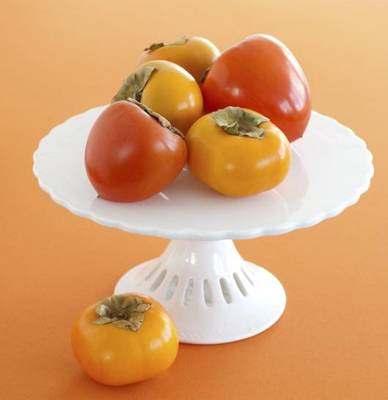Australian Persimmon

Australian Persimmon
Add a little piece of perfect to autumn with the Australian Persimmon which is available from February until June. One amazing fruit, two delicious varieties and endless possibilities!Australian orchards are turning golden with the orange hue of the divine and decadent Persimmon, in season from February until June.
"With only a short season, these autumnal fruits will be snapped up quickly," says Persimmon ambassador Warren Turnbull, Head Chef and Owner of two-hatted Assiette and newly opened District Dining. "These golden beauties are an indulgent fruit that will lighten up any autumn dish."
Turnbull says the key to making the most of Persimmons this autumn is to understand there are two varieties: Sweet Persimmon and Original Persimmon. "Both varieties differ in flavour, texture and consistency and while known for their honey sweet and mild taste with a hit of cinnamon and spice, people are often confused by the two," he adds.
Sweet Persimmons are also known as non-astringent persimmons or as Fuyus. They are a larger, round fruit with a diameter of around 10cm with a slightly flattened top. They range in colour from pale orange to a deep red-orange when ripe.
When selecting a Sweet Persimmon ensure fruit is firm to touch. The fruit can be eaten when crisp and crunchy like an apple; you can eat the skin too.
"I love the crunch and hard texture of a Sweet Persimmon. Their firm flesh means that they hold their shape and are therefore perfect in salads and great additions to cheese plates," says Turnbull.
On the other hand, Original Persimmons are slightly heart-shaped fruits. The pale to burnt-orange coloured fruit is ready for eating and sweetest when the flesh is soft and jelly-like.
"Original Persimmons have been consumed in Australia for over 150 years. Its translucent orange flesh must be eaten when it has a soft, squashy, jam-like consistency. However, unlike the rotund Sweet Persimmon the Original Persimmon must be handled with care," adds Turnbull.
"Be careful not to confuse your Persimmons," warns Turnbull. "If you eat an Original Persimmon when it is too hard the astringency will make the fruit taste bitter."
Persimmons can be eaten fresh or used in cooking. Warren believes the natural sweetness of both Sweet Persimmons and Original Persimmons compliment either sweet or savoury dishes.
"The versatility of the two varieties of Persimmons means they should be a staple on the shopping list throughout the cooler months. Persimmons shine when paired with meat, fish, curry, salad or a dessert. Invigorate autumn classics with the ultimate ingredient," says Turnbull.
"For a decadent salad, combine finely sliced Sweet Persimmon, rocket leaves, torn basil and finely sliced pancetta. Sprinkle with toasted pine nuts and finish with a splash of caramelised balsamic for a chic and simple taste sensation.
"I love chopping off the top of an Original Persimmon and simply devouring it with a spoon. However, the soft consistency of the Original Persimmon makes them a decadent addition to classic dishes like jam, chutney, preserves, pudding, crumbles and other desserts.
"Or go Persimmon crazy with roasted pork fillet with spicy Persimmon chutney made from Original Persimmons served with a Persimmon salad made from Sweet Persimmons - ultimate Persimmon indulgence," suggests Turnbull.
2011 Season
Flooding and cyclone have not dramatically affected Persimmon growers.
"The 2011 Persimmon season looks positive with favourable growing conditions across Persimmon growing regions," says Kent Andrew, Chairman of the Persimmon Industry Advisory Committee.
"Persimmons are grown in most states of Australia, with major growing regions in south east and sub-tropical QLD, NSW, northern Victoria, north west SA and in south west WA. Queensland is the biggest producer of Persimmons in Australia. Earlier season fruit (mid-February until April) comes from the north while later season fruit (April to the end of June) comes from the southern region.
"Consumers can expect to find great quality fruit in-store from late February," adds Andrew.
Annually Australian Persimmon growers produce 2,100 tonnes of Persimmons or 10.5 million Persimmons (approximately).
Health Golden Treats
These bountiful beauties contain a very high level of antioxidants, comparable with strawberries and blueberries. A great snack at your desk or in the lunchbox, Persimmons are also a good source of vitamin A and C, are high in fibre and fat free.
Selection
Choose Persimmons that are smooth, plump, glossy and well-rounded with their calyx still attached. The fruit can range in colour from a pale orange to a deep red-orange, depending upon variety and stage of the season. Fruit with surface blemishes are fine to eat as flavour and eating quality is unaffected. Sweet Persimmons form the majority of the Australian crop. While these sweet treats are most readily available, Original Persimmons can be found at selected green grocers.
Handling and Storage
Despite being firm to the touch, handle Persimmons with care as their thin skin is delicate and bruises easily. Sweet Persimmons that have gone soft are perfect for use in cooking - but they must be handled gently.
When ripe, Persimmons should be stored on their own at room temperature, out of the fridge, for up to five days.
After removing the leaves, prepare the Persimmon by slicing the fruit or cutting it into quarters.
MORE





